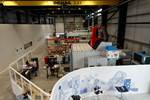Why out of autoclave processing is good for the composites industry
Consultant Bob Lacovara (Convergent Composites, Perkasie, Pa.) calls out the cost advantages of out-of-autoclave processing.
Share
There are structural composites, and then there are structural composites. Depending on the context, the mechanical properties required for applications can vary over a wide range. Boat hulls, for example, require stiffness and resistance to impact loading. This entails building sufficient laminate bulk to resist dynamic slamming loads. In the case of an underground storage tank, relatively low-modulus materials can be used and the section modulus (thickness) is designed to resist relatively static loads. Aerospace composites, however, are different. They must be both very low in weight and very high in modulus, a requirement that puts them at the edge of the performance envelope.
The hallmark of advanced composites is to provide maximum tensile and compressive properties per specific weight. There are three major characteristics that influence the development of advanced composites properties: fiber modulus (tensile), fiber volume fraction and laminate void content.
Typical aerospace-grade composites produce a void content of about 1 percent, while other composites often exhibit void contents from 3 to 5 percent. Void content is relevant because as it increases, mechanical properties decrease. In a highly loaded carbon fiber laminate, an increase in void content from 1 to 3 percent can result in a 20 percent loss in laminate mechanical properties. Elsewhere in the composites industry, the loss of specific strength is generally compensated by adding bulk to the laminate. But such compensation is unacceptable in aerospace applications.
Because the void content and fiber-volume fraction are so important to the performance of aerospace composites, autoclave processing has been the traditional method to optimize specific strength. Although autoclave processing is typically paired with high-quality/validated laminates of well-characterized materials, and it is the primary method qualified for Tier 1 component manufacturing, it is not without drawbacks. Autoclaves are highly capital-intensive, expensive to operate (energy costs are high) and they limit component size. There are no means by which to make in-process adjustments to vacuum bags or tooling. Labor intensity and slow cycle times severely limit production volume. Further, there are practical barriers. The projected growth of aerospace composites could outpace the available autoclave capacity and at the same time fail to provide economic justification to ramp up the number of large autoclaves in operation. Aerospace composites have not been driven by cost in the past, but as their use expands into airframes and other primary structures, cost will become a more influential factor.
Given these realities, the aerospace industry is looking to out-of-autoclave (OOA) processing for its next-generation structures. The traditional prepreg process requires the additional pressure of an autoclave to produce the desired ply consolidation and associated laminate void content. But emerging vacuum-bag-only (VBO) prepregs feature modified resin matrix rheology that provides better flow characteristics and, as a result, reduced void content. At the same time, vacuum infusion processing (VIP) is advancing in application and qualification for high-performance components.
The fundamental advantage of VIP is its ability to consolidate the fiber pack before the liquid resin is introduced. After the dry laminate is debulked and atmospheric gas is evacuated from the tool cavity, the conditions that create microvoids are greatly reduced. Dry-fiber preconsolidation, then, enables an atmospheric-pressure vacuum bag to produce a laminate with acceptable void content for high-performance applications.
OOA processing not only eliminates the expense of autoclave processing, but also reduces tooling costs. Further, there are multiple variations of the process that can be fine-tuned for specific applications, and the performance/cost ratio is moving toward what is required for sustainable growth within the industry.
Also, OOA processing is good for the overall composites industry in three important ways:
- It validates the use of composites for an expanded spectrum of applications.
- It places VBO processing within reach of a larger number of molders and end-use applications, including those in the aerospace industry.
- Well-developed VIP is opening doors of high-end structural applications to processors who cannot justify an investment in autoclave curing.
Ultimately, the aerospace composites industry can benefit by embracing faster and more cost-competitive OOA methods, and processors who already use them in other markets will benefit from the refinements that will result as aerospace engineers adapt them to meet the demanding weight, performance and dimensional tolerances of aircraft.
It has been said that there is no shortage of customers for composite products, if the price is right. We have the opportunity to test that axiom by advancing OOA processing.
Related Content
Composite resins price change report
CW’s running summary of resin price change announcements from major material suppliers that serve the composites manufacturing industry.
Read MoreFrom the CW Archives: Airbus A400M cargo door
The inaugural CW From the Archives revisits Sara Black’s 2007 story on out-of-autoclave infusion used to fabricate the massive composite upper cargo door for the Airbus A400M military airlifter.
Read MoreNovel composite technology replaces welded joints in tubular structures
The Tree Composites TC-joint replaces traditional welding in jacket foundations for offshore wind turbine generator applications, advancing the world’s quest for fast, sustainable energy deployment.
Read MorePlant tour: Albany Engineered Composites, Rochester, N.H., U.S.
Efficient, high-quality, well-controlled composites manufacturing at volume is the mantra for this 3D weaving specialist.
Read MoreRead Next
VIDEO: High-volume processing for fiberglass components
Cannon Ergos, a company specializing in high-ton presses and equipment for composites fabrication and plastics processing, displayed automotive and industrial components at CAMX 2024.
Read MoreAll-recycled, needle-punched nonwoven CFRP slashes carbon footprint of Formula 2 seat
Dallara and Tenowo collaborate to produce a race-ready Formula 2 seat using recycled carbon fiber, reducing CO2 emissions by 97.5% compared to virgin materials.
Read MorePlant tour: Daher Shap’in TechCenter and composites production plant, Saint-Aignan-de-Grandlieu, France
Co-located R&D and production advance OOA thermosets, thermoplastics, welding, recycling and digital technologies for faster processing and certification of lighter, more sustainable composites.
Read More






















